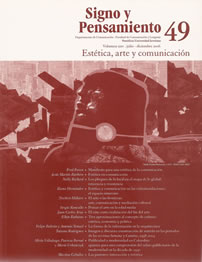Cinema as fulfillment of the end of art: between purity and impurity
##plugins.themes.bootstrap3.article.details##
Many have claimed that the ideal of art advocated by modernism has come to an end. The story founded by modern art no longer applies to certain contemporary practices, which has led to think that, beyond being necessary a new story that accounts for art in its various manifestations, the end of stories must be recognized, the inability to produce a new narrative to replace the modernist one to include and legitimize art forms today. It is this end of narratives that we can understand, following Arthur Danto, as the end of art, a concept that designates the transition from modern art to contemporary art. The objective of this text is to understand what place the cinema occupies within this transit —which, more than chronological, is conceptual—, by analyzing the notions of purity and impurity in art.
Teoría del cine, Arte moderno, Arte contemporáneo, pureza e impureza del arte, fin del arteteoria do filme, arte Moderno, arte contemporânea, pureza e impureza da arte, fim da arteThe theory of moving pictures, modern art, contemporary art, art purity and impurity, purpose of art.
Badiou, A. (2004), “El cine como experimentación filosófica”, en Yoel, G. (comp.), Pensar el cine 1. Imagen, ética y filosofía, Buenos Aires, Manantial, pp. 23-81.
— (2005), Imágenes y palabras. Escritos sobre cine y teatro, Rodríguez, M. C. (trad.), Buenos Aires, Manantial.
Bazin, A. (1994), ¿Qué es el cine?, López Muñoz, J. L. (trad.), Madrid, Rialp.
Danto, A. C. (1999), Después del fin del arte, Neerman, E. (trad.), Barcelona, Paidós.
— (2002), La transfiguración del lugar común. Una filosofía del arte, Mollá Román, A. (trad.), Barcelona, Paidós.
Deleuze, G. (1984), La imagen-movimiento, Agoff, I. (trad.), Barcelona, Paidós.
— (1985), La imagen-tiempo, Agoff, I. (trad.), Barcelona, Paidós.
Epstein, J. (1957), La esencia del cine, Buenos Aires, Galatea Nueva visión.
Greenberg, C. (1960), “Modernist Painting” [en línea], disponible en: http://www.sharecom.ca/greenberg, recuperado: 1 de octubre de 2006.
— (2002), Arte y cultura. Ensayos críticos, Beramendi, J. G. (trad.), Barcelona, Paidós.
Marzabal, I. (1998), Wim Wenders, Madrid, Cátedra. Rancière, J. (2000), Le partage du sensible. Esthétique et politique, Paris, Fabrique.
— (2004), “Lo inolvidable”, en Yoel, G. (comp.), Pensar el cine 1. Imagen, ética y filosofía, Buenos Aires, Manantial.
— (2005a), La fábula cinematográfica, Roche, C. (trad.), Barcelona, Paidós.
— (2005b, diciembre), “Las poéticas contradictorias del cine”, en Pensamiento de los Confines, núm. 17, 9-17.
Vertov, D. (1973), Cine-ojo. Textos y manifiestos, Llinás, F. (trad.), Madrid, Fundamentos.

This work is licensed under a Creative Commons Attribution 4.0 International License.


